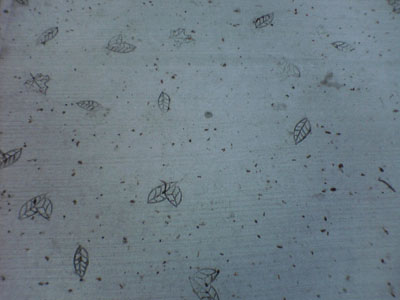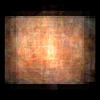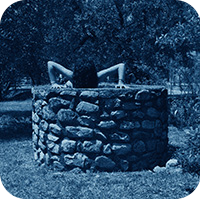Wet cement botany
It took me few blocks to realize that Vancouver’s sidewalks come preloaded with leaf impressions. The relief is a bit high (extra heavy foliage?), but the effect is kinda nice. Fossils of tree-lined avenues that don’t actually exist.
So average
Amazing the complexity that simple innovations beget. Flickr continues to inspire and facilitate some really astonishing technical and artistic development. The latest is a set of images created by a user named brevity by averaging 50 photos of a single type of subject — an eye, a candle, a mountain, etc. The result manages to be both numinous and chthonic. Have a look-see.
And if you like this sort of layering, have a peek too at the work of Matt Wenc. He’s an artist (and good friend) who works in thick grids of color that often achieve the same kind of rear-lighting effect that the Flickr averages do.
Via alt text.
UPDATE: Matt points us to the artist Jason Salavon. Check out his averages of residential real estate markets.
Content provider

You gotta admire the audacity of this. Guy walks into four of the most prestigious art museums in NYC, hangs his own art complete with labels, snaps some shots, and walks out. If nothing else the act itself deserves mention as a superb piece of performance art.
He says – “This historic occasion has less to do with finally being embraced by the fine art establishment and is more about the judicious use of a fake beard and some high strength glue.” Banksy continues -“They’re good enough to be in there, so I don’t see why I should wait”
Staff at the New York Met discovered and removed their new aquisition early Sunday morning while Banksy’s discount soup can print took pride of place in the MoMA for over three days before being torn down.
As of now, the other two pieces currently remain firmly in place.
Full photos here.
Via Kottke.
UPDATE: MoMA took Banksy’s piece down (it was not in a gallery to begin with), but they didn’t throw it out. Wonder what they’ll do with it?
A CTA Map for 2055
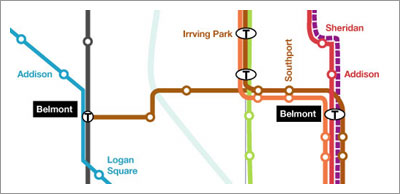
Proposed Roscoe Village Brown Line spur that would make my life approximately 1000 times easier
Craig Berman, author of the wonderful Fueled by Coffee blog, has a great piece up at Gaper’s Block. Using the CTA’s proposed Circle Line as a starting point, he meticulously outlines a subway plan for the future of Chicago.
The CTA needs to form a mass transit network — as opposed to the current radial commuter rail. Right now, all lines lead to the Loop in the morning and back out in the afternoon — these lines don’t take into account that a lot of living happens outside of the skyscrapers of the Loop. What happens when I want to get from Bucktown to Wrigleyville? Andersonville to the West Loop? Hyde Park to Pilsen? Little Village to Logan Square? These rides are a pain in the ass — they’re slow, indirect, and require multiple bus transfers. Why can’t you move from the North Side to the northWest Side without going downtown first? I want answers, dammit!
Amen, brother. Where do I sign up to help digging?
See also: Art of the subway
Umbrella locker in Nanjing
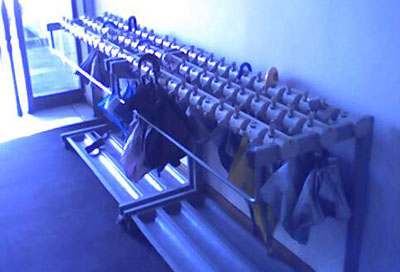
Note the drip runoff troughs. Nice design.
Beasts in Babylon?
The Guardian reports on widespread destruction of cultural monuments in the Iraq city of Babylon — not by looters, but by U.S. troops. Apparently we’ve set up a military depot there. Um, hello. You’d think with the Olympics just in Greece we’d be saturated with knowledge that this is a very bad idea. Say it with me: ancient structures make bad armories. Repeat.
Where were the much-ballyhooed cultural heritage consultants to the military on this campaign? Ugh.
(Thanks, Mark.)
Art of the subway
It’s a day for snatches of free music: bells,
sirens, a saxophone echoing the spheres,
industrial-strength percussion from a tribe
of project kids, the techno beat
of sprockets as trains reel overhead
like runaway strips of film.
— Twenty Feet Above The Street, Stuart Dybek
The London Underground map — benchmark for all transit information design since it was created in 1933 and a work of art in its own right — was based on an electrical circuit diagram. There’s something about depicting conduits for the transport of humans using visual language developed to denote conduits for the movement of electrons that is captivating to me, a suggestion of what we really want: seamless teleport from point A to point B.
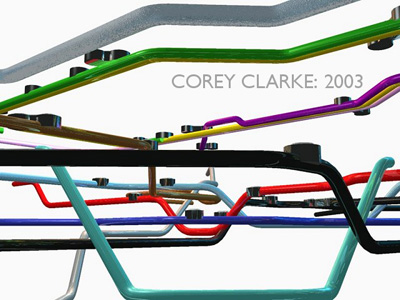
3D Tube Map, Corey Clarke
Subways have an interesting relationship to art. For a period the cars themselves were the most desirable canvases available. Then the art went inside, became sanctioned. But most often subways are the subject-matter, creative fodder for the good, the mediocre, and the atrocious. Sometimes subway trains are the means of art production themselves. Or even the means of documenting the process of production. Now that’s travelling full-circle.
Wheels and towers

Daniel Libeskind became a celebrity when he was selected, amidst much controversy and eventual, bitter infighting, to provide the master architectural plan for Ground Zero. But before that, he was a minor hero of mine for orchestrating the construction of a funky 16th century contraption called the “reading wheel,” basically a precursor of modern hypertext. Libeskind’s studio took great pains to reproduce this machine:
“To try to become the pure medieval craftsman — that’s really the object of this exercise … So we did it that way. We got up at the crack of dawn, four o’clock in the morning. We built this machine in a small place without any power tools, just with hand tools; with no electricity, just with candlelight. We went to bed early because with candlelight you can’t work late. And we did it in silence because there is nothing to talk about when you work like that.”

One wonders if real students of Libeskind’s style and oeuvre could chart a linkage between his interest in the reading wheel and the twisting, aerie-like Freedom Tower. Perhaps it is the turbines in the lattice at the top of the structure? (Not sure about that one; didn’t Skidmore add that?) Who knows, but I like the tower better for it.
The wheel itself, though not Libeskind’s version, pops up from time to time in literature and art. Richard Lester used some version of the wheel as a pratfall prop in his Three Musketeers. And, most recently, in The Confusion Neal Stephenson uses the wheel, called a Bücherrad, as a literary device (literally) in the lab of Gottfried Leibniz. Wheel on over to Amazon and read a bit.
Elegantly primitive, technologically advanced, but most of all beautiful in how it addresses a simple need, the wheel is truly captivating. If Libeskind achieves half that with his tower at Ground Zero he’ll have accomplished quite a lot.
Re-MoMA

The Museum of Modern Art in NYC re-opens to the public tomorrow after a two-and-a-half year absence from Manhattan. I’ve been in the new space a few times during construction and last night I was lucky enough to go to the re-opening party. More on that in a second. First, the building. Impressive. There’s a new spaciousness to the galleries that really allows the works of art to exist in meaningful relation to one another rather than simply next to one another. Yoshio Taniguchi has made some great choices with interior windows and portals, teasing visitors (spot Matisse’s Dance ) with snatches of art seen from afar. Perhaps my favorite part of the new architecture are the windows (specially treated to minimize direct sunlight) that look out onto the sculpture garden and the museum’s “architectural neighbors” in Midtown. Upcoming tours available in the museum will actually make a point of commenting on the architecture visible from the windows, an extension of the museum’s architectural holdings — literally a museum outside the walls. I like that concept.
The party was well done. DJ’s on every floor, a band on the top floor, open bar, cafés turned into hip lounges. One can’t complain. No red wine though. “We’re MoMA. We don’t do red wine,” I was told. I wasn’t cool enough to construct a comeback so I can only think he meant they don’t serve red wine because of the staining possibilities. But maybe there’s another story. Like, we’re MoMA and red wine is so The Whitney.
A few photos of the space and event are available.
On Exhibit
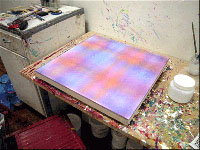
My good pal Matt Wenc will participate in the 34th Pilsen Artists Open House this weekend. If you’ve never experienced Matt’s work this will be a real treat. The thick, layered grids of nebulous color that characterize his work are absolutely mesmerizing. The event itself allows artists to open their studios to the public alongside performances and exhibitions in the neighborhood galleries. Matt has also invited artists Julie Vari and Michael Wille to show their work in his space. His studio will be open this Friday 6-10 pm, Saturday and Sunday 12–7 pm at 727 W. 19th St. Stop by!

